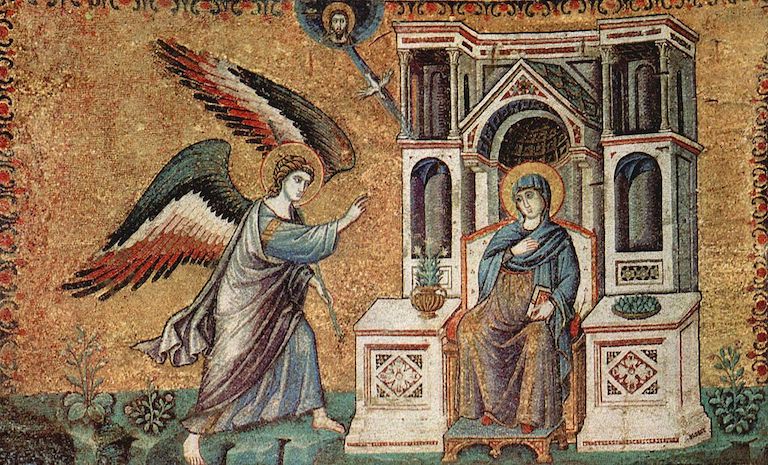As of last week, lockdown restrictions have been almost fully lifted in Italy. Shops, restaurants, cafés, etc. are reopening. Italians can now see friends, family, and colleagues freely, with some local discretion being exercised by each region. Churches are also now in “phase 2” of re-opening. In one of the oldest basilicas in Rome, Santa Maria in Trastevere, built in the 4th century, the first Mass was just held after almost three months of the nation-wide lockdown.
A sign at the entrance of the Church, however, says that those who have a fever of 37.5 C (99.5 F) or higher, influenza symptoms, or have been in contact with someone positive with COVID-19 cannot enter. For everyone else, a facemask, hand sanitizing, and one-meter distancing are conditions of entry.
You would expect that after weeks of a forced lockdown, the first Mass after reopening would have drawn many faithful once again to their place of worship, especially in one of the most prominent basilicas in Rome. But there were only about fifty people attending, about five of whom were nuns. All the benches had been removed for social distancing purposes. Chairs a meter or more apart were carefully positioned across the inside of the Church.
“People are still afraid, even of coming back to God,” one woman said, who used to attend the basilica regularly. “Personally, I think the Church has been very helpful during this crisis. It went from serving inside the Church to serving outside of it,” she added.
Churches were among the first institutions to be quarantined in Italy. The Italian bishops were relatively silent at the beginning; and their passivity in the face of government restrictions generated quite a bit of controversy. But the initial silence changed as the clergy began to compensate, not just by organizing online streaming Masses and virtually keeping in touch with its faithful, but also by taking a more active part in the community.
In the piazza in front of Santa Maria in Trastevere, for instance, large breakfasts are organized three times a week for those in need. Before the pandemic, about ninety people would show up. That number has more than doubled. A volunteer explained: “People are coming from outside of Rome, by train, just to get our breakfast and food boxes.”
The church provides fruit juices, marmalade, bread, biscuits, coffee and tea, as well as lunches for people when they return home. Initially, most of the people in need were homeless. Now there are many who are struggling with poverty or who have lost their jobs during the pandemic. Volunteers have multiplied as well; several journalists, who initially came to report on the charity, now help out on a regular basis.
The volunteers, too, have to undergo strict checks by the church, which measures their temperatures to make sure they don’t have a fever; they have to sanitize their hands, use gloves, practice social distancing, and wear masks. And the church also routinely subjects itself to strict sanitization. Chairs are disinfected before and after someone sits on them, and four times a week the whole church is sanitized with a vaporizer.
“We bought all this equipment ourselves; we are more sterilized as a church than many supermarkets,” the parish priest of the basilica, Don Marco Gnavi told me. In order to keep the focus on helping people and defeating the virus, he refrained from commenting on why places of worship, unlike supermarkets, were not allowed to remain open during the lockdown.

A parish assistant, however, said that some regulations imposed by government authorities did not make much sense. For example, only a maximum of 200 people can enter a church for Mass, even though some churches can take in many more. Santa Maria in Trastevere, for example, has space for at least 250 people even with the 1-meter-plus distance between chairs. And that is nothing compared with a massive building like St Peter’s Basilica.
All this is mere detail, however, which clergy are willing to put up with – at least for now – to make the reopening of Masses as smooth as possible.
During the first reopening Mass, photographers were conspicuously rushing around trying to get the best shots – especially when the priests, wearing gloves, were distributing the Eucharist. Usually, the faithful receive Communion, of course, by lining up in front of the altar. In the current situation, the priests move among the faithful, who are seated in well-spaced chairs.
The change indicates how Church leaders now feel responsible to serve the laity for the common good. In fact, “common good” is a phrase routinely emphasized when people talk about the restrictions.
“We have a collective responsibility to be prudent and protect those who are most fragile with a vision for the common good,” Don Marco Gnavi told me. When I asked him about criticisms that the Church has received for not remaining open, he replied, “Faith is bold, but it is not fatalistic or presumptuous.”
Don Marco points to St. Luke, an evangelist and physician, as a counter-example to the false dichotomy between science and religion that is often used to claim the Church should rebel against scientific authorities. “Jesus cured the sick; he never said illness should be ignored.”
Italian churches, like churches in other nations, were forced into becoming a virtual presence during the lockdown. Whether that was necessary or an overreaction is debatable and will have to be sorted out when the virus recedes and we can form a better picture of what is it and is not.
But now they are reopening with a strong sense of civic duty and a demonstrable ability to adapt in carrying out their divine mission, even in the midst of a pandemic.
*Image: Annunciation by Pietro Cavallini, c. 1300 [Basilica of Santa Maria in Trastevere, Rome]















